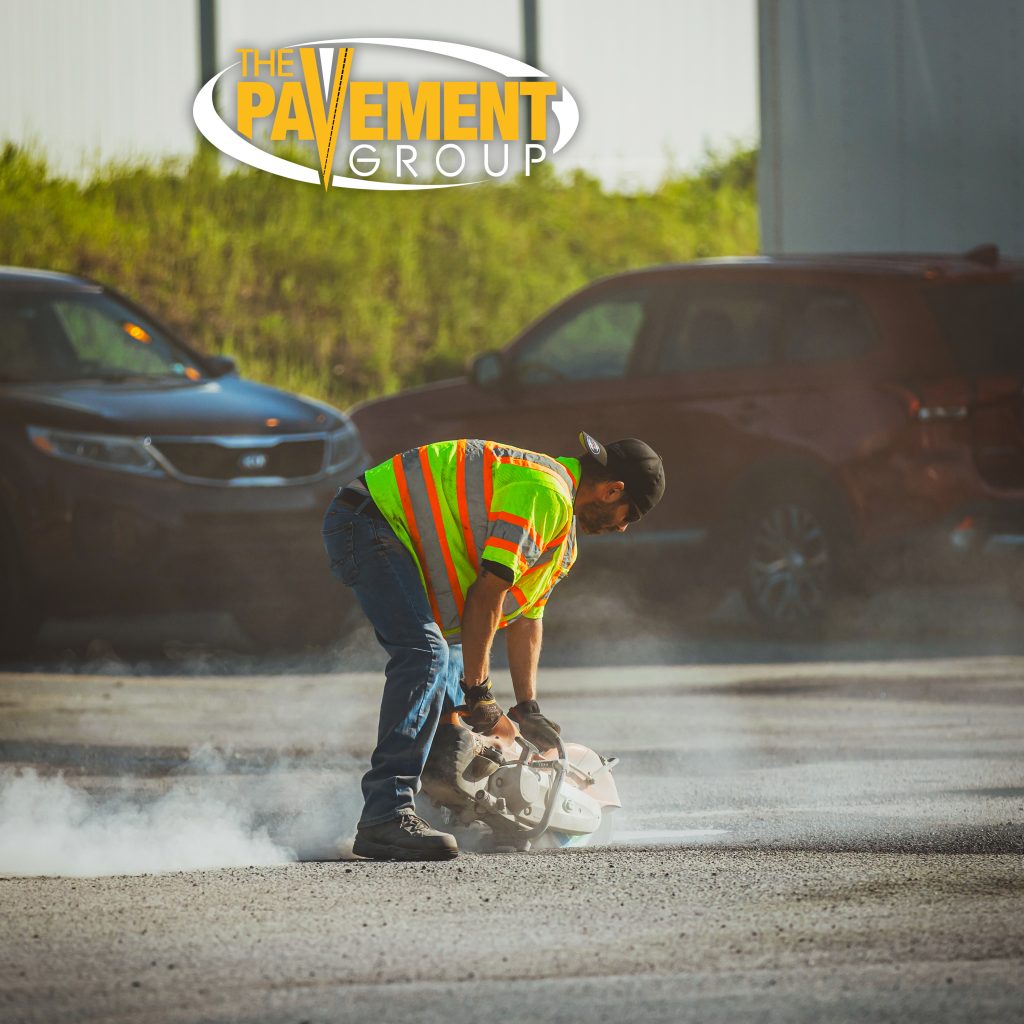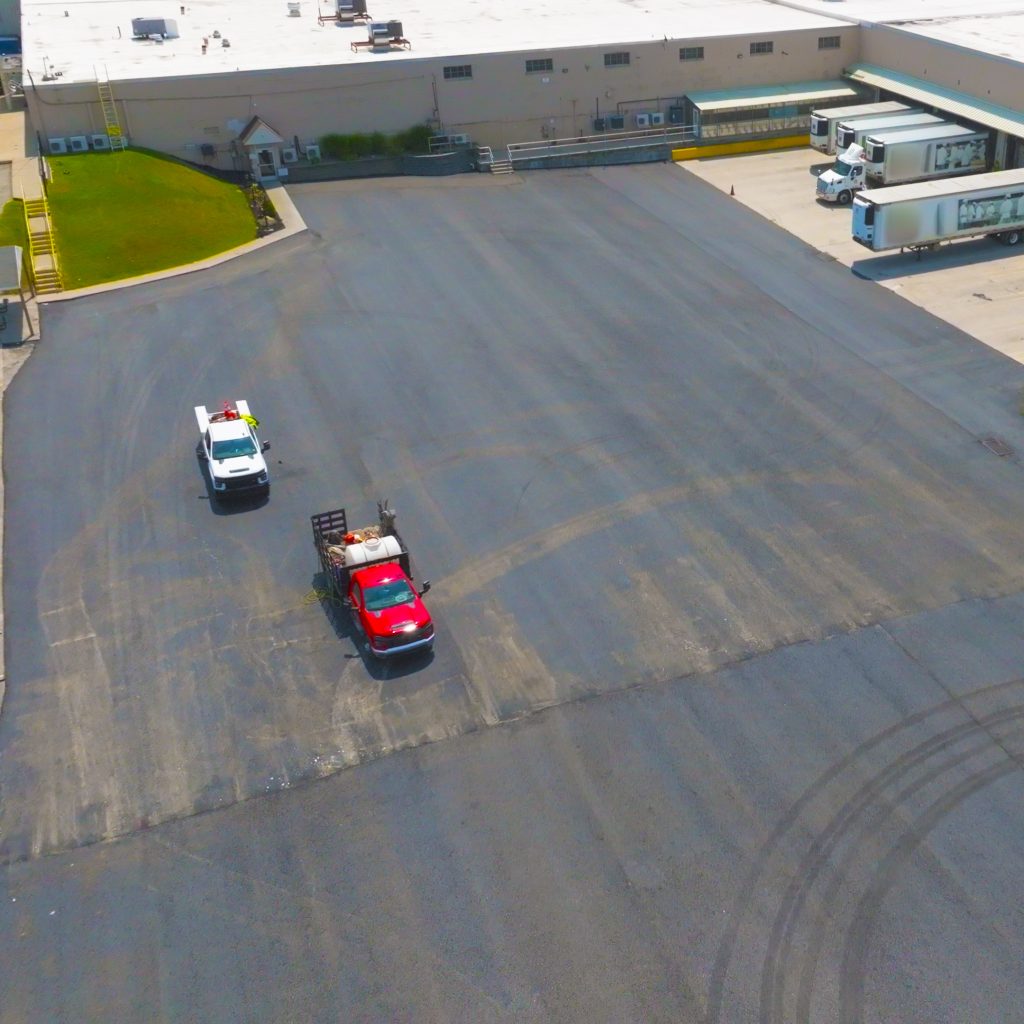First impressions matter, especially in retail. Your parking lot is often the first thing customers see before entering your store. If it’s cracked, faded, or uneven, it sends the wrong message. Retail parking lot repaving is more than necessary!
A well-maintained parking lot shows that you care about safety, accessibility, and your brand image. At The Pavement Group, we help retail property owners throughout the Phoenix metro area and beyond keep their lots smooth, safe, and visually appealing.
Let’s explore the most common signs your parking lot needs repaving and why addressing them early saves you time and money.
Cracks Are Spreading Across the Surface
Small cracks may not look serious, but they’re often the first sign of deeper pavement issues. In Arizona’s hot climate, heat expands asphalt, making cracks worse over time.
When water seeps into cracks, it erodes the foundation underneath, leading to more costly repairs later. If your parking lot looks like a spider web of cracks, it’s time to act.
Professional asphalt repaving restores surface strength and prevents structural damage before it becomes a liability.
Potholes Are Appearing Everywhere
Potholes are more than just an eyesore. They’re a safety hazard for customers and vehicles. They develop when moisture weakens the asphalt layers and traffic pressure breaks the surface apart.
In retail environments, where cars come and go all day, potholes form faster than you think.
Ignoring them can lead to property damage claims and unhappy visitors. Repaving eliminates the problem completely and restores a smooth, professional look to your property.
Fading Lines and Dull Pavement
Noticed parking lines that are barely visible? That’s a clear sign your pavement is wearing out. The hot Phoenix sun causes paint to fade and asphalt to oxidize, turning it gray and brittle.
Faded striping confuses drivers, reduces parking efficiency, and makes your property look neglected. Repaving gives you a fresh surface for bright, long-lasting markings and better organization.
Drainage Issues and Standing Water
Water pooling in your parking lot after every rainstorm isn’t normal. Poor drainage signals foundation issues beneath the asphalt.
When water can’t flow properly, it seeps through cracks, eroding the base layer and weakening the pavement. Over time, this leads to dips, potholes, and even structural failure.
Repaving with proper grading ensures water drains away smoothly, protecting your investment and your customers’ safety.
Uneven or Warped Surfaces
If your parking lot feels bumpy when you walk or drive across it, the surface may be warping. Heavy vehicles, poor compaction, or subgrade failure often cause these uneven areas.
Uneven pavement not only affects appearance but also poses a tripping hazard. Retail centers in busy areas like Scottsdale or Mesa need flat, stable lots to handle traffic efficiently.
Repaving levels the surface and creates a more professional, comfortable experience for both drivers and pedestrians.
Constant Repairs and Temporary Fixes
Are you patching the same spots again and again? If so, your pavement’s lifespan is likely over.
Temporary fixes like sealcoating or patching may extend surface life for a while, but they won’t solve underlying structural problems.
If repairs are becoming frequent and costly, repaving offers a long-term solution. A full resurfacing or reconstruction ensures durability for many years to come.
Visible Signs of Aging Asphalt
Asphalt has a lifespan of about 15 to 20 years. After that, it begins to deteriorate due to sunlight, water, and vehicle wear. If your lot looks dull, brittle, or faded with visible cracks, repaving is the best option.
Fresh asphalt not only enhances curb appeal but also boosts your property’s value and safety compliance. A new surface makes your retail center look modern, clean, and ready for business.
Safety Concerns for Shoppers and Vehicles
Retail centers depend on smooth, safe parking lots for customer satisfaction. Damaged pavement creates risks for slips, trips, and vehicle damage.
Business owners are responsible for maintaining a hazard-free environment. Failing to do so can result in accidents, liability issues, and loss of reputation.
Repaving your lot eliminates those risks while making your property more welcoming and compliant with accessibility standards.
Customer Feedback and First Impressions
Customers notice your parking lot before they notice your storefront. If they complain about rough surfaces or poor parking visibility, it’s time to take action.
A damaged lot can discourage customers from returning, even if your products and services are great. Investing in repaving shows you care about the overall experience.
“Our Parking Lot Now Matches the Quality of Our Store”
“We operate a small shopping plaza in Tempe, and our parking lot has become a nightmare. Cracks, faded lines, and uneven patches were everywhere. Customers even mentioned it in reviews. After working with The Pavement Group, we decided to repave the entire lot. Their crew handled everything efficiently—from planning to cleanup. Now the surface looks brand new, and our customers instantly noticed the difference. Foot traffic has improved, and the lot finally reflects the pride we have in our business.”
— Rachel M., Tempe, AZ
Rachel’s experience is a perfect reminder that investing in your property pays off in visibility, safety, and customer satisfaction.
Why Repaving Is a Smart Business Decision?
Repaving might seem like a big expense, but it’s actually a smart, long-term investment.
A fresh, durable parking lot prevents accidents, reduces maintenance costs, and enhances your brand image. In competitive retail markets like Phoenix and Gilbert, first impressions can make all the difference.
New pavement instantly boosts curb appeal and helps attract new customers to your property.
Your Lot Deserves a Fresh Start!
Don’t let cracks and potholes send the wrong message about your business. A smooth, freshly paved parking lot shows professionalism, care, and commitment.
At The Pavement Group, we make repaving simple, affordable, and stress-free. From detailed written estimates to flawless execution, we handle every step with precision.
Whether you manage a retail plaza, strip mall, or standalone store in the Phoenix metro area, we’ve got you covered.
Call us today to schedule your free site evaluation. Give your customers a better first impression. One smooth drive at a time.
Frequently Asked Questions
1. What are the top signs your retail parking lot needs repaving?
Common signs include deep cracks, potholes, faded striping, and standing water. These issues indicate the pavement’s foundation is deteriorating. Repaving restores safety, improves appearance, and prevents further structural damage.
2. How often should retail parking lots be repaved?
Most parking lots need repaving every 15 to 20 years, depending on usage and maintenance. Heavy traffic and harsh weather can shorten this lifespan. Regular inspections help determine the right time for repaving.
3. Why are cracks appearing in my retail parking lot?
Cracks form due to weather changes, water damage, or aging asphalt. When left untreated, they expand and weaken the pavement’s base. Repaving eliminates the cracks and restores a smooth, durable surface.
4. How do potholes affect retail parking lot safety?
Potholes create trip hazards for pedestrians and damage vehicles. They can also collect water, leading to further erosion beneath the surface. Repaving ensures a safe, even surface for both customers and vehicles.
5. What causes fading in parking lot lines and markings?
Constant exposure to sunlight and traffic wears away paint and surface coatings. Faded lines reduce visibility and organization for drivers. Repaving provides a clean surface for new, long-lasting markings.
6. Can poor drainage mean my parking lot needs repaving?
Yes, standing water often signals poor drainage or foundation problems. Over time, trapped water erodes asphalt layers and weakens structural integrity. Repaving allows for proper grading to improve drainage and prevent future damage.
7. Why does my parking lot surface look uneven or warped?
Uneven pavement results from heavy loads, water infiltration, or poor installation. Warped areas can cause accidents and damage to vehicles. Repaving corrects these issues, providing a stable and professional surface.
8. How do I know if repairs are no longer enough?
If cracks and potholes return soon after repairs, repaving is likely needed. Repeated patching becomes costly and less effective over time. Full repaving offers a long-term solution with stronger materials and structure.
9. Does repaving improve curb appeal for retail stores?
Yes, a freshly paved parking lot instantly enhances a property’s appearance. Customers notice clean, well-marked lots and associate them with professionalism. Improved curb appeal often leads to increased customer satisfaction and foot traffic.
10. How does repaving help prevent future maintenance costs?
Repaving strengthens the pavement foundation and eliminates recurring surface issues. A new layer resists cracks, water damage, and wear from traffic. Investing in repaving now reduces long-term maintenance expenses and liability risks.


